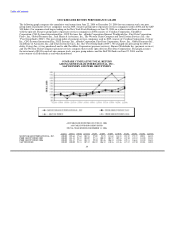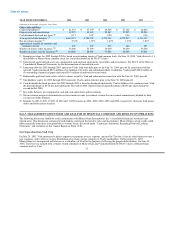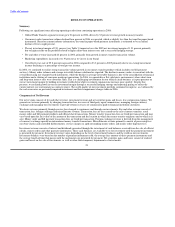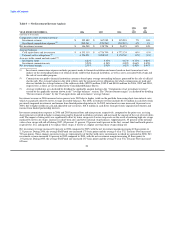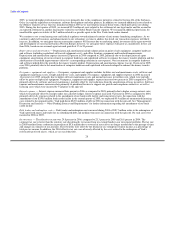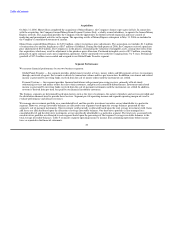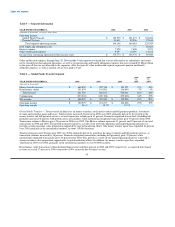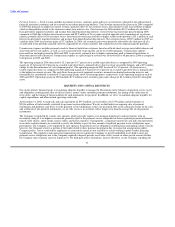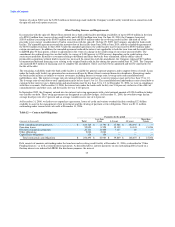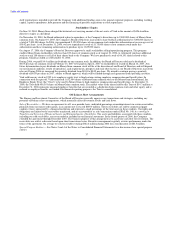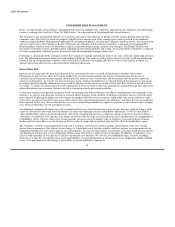MoneyGram 2006 Annual Report Download - page 31
Download and view the complete annual report
Please find page 31 of the 2006 MoneyGram annual report below. You can navigate through the pages in the report by either clicking on the pages listed below, or by using the keyword search tool below to find specific information within the annual report.
Table of Contents
2005, we incurred higher professional services costs primarily due to the compliance initiatives related to Section 404 of the Sarbanes-
Oxley Act and the regulatory environment, software development and other projects. In addition, we incurred additional costs related to
the eMoney Transfer service that was launched in March 2004 as we moved processing in-house from a third-party processor during
2005. During the first quarter of 2005, we incurred $2.2 million of costs related to the settlement of one legal matter and the accrual for
an expected settlement in another legal matter related to our Global Funds Transfer segment. We recognized additional provisions for
uncollectible agent receivables of $6.7 million related to a specific agent in the New York check casher channel.
We continue to see a trend among state and federal regulators toward enhanced scrutiny of anti-money laundering compliance. As we
continue to add staff resources and enhancements to our technology systems to address this trend, our transaction expenses will likely
increase. In addition, we anticipate that our transaction expenses will increase due to marketing spend, investment in the agent network
and development of our retail network in Western Europe; however, we anticipate these expenses will grow at a moderately slower rate
than 2006, based on our assumed agent network growth of 15 to 20 percent.
Depreciation and amortization — Depreciation and amortization includes depreciation on point of sale equipment, computer hardware
and software (including capitalized software development costs), and office furniture, equipment and leasehold improvements.
Depreciation and amortization expense increased 20 percent in 2006 compared to 2005, primarily due to the depreciation of agent
equipment, amortization of our investment in computer hardware and capitalized software to enhance the money transfer platform and the
amortization of leasehold improvements (offset by a corresponding reduction in rent expense). Our investments in computer hardware
and software helped drive the growth in the money transfer product. Depreciation and amortization expense was up 10 percent in 2005
over 2004, primarily due to the amortization of computer hardware and capitalized software developed to enhance the money transfer
platform.
Occupancy, equipment and supplies — Occupancy, equipment and supplies includes facilities rent and maintenance costs, software and
equipment maintenance costs, freight and delivery costs, and supplies. Occupancy, equipment and supplies expense in 2006 increased
14 percent over 2005, primarily due to higher software maintenance costs and normal increases in facilities rent, which were partially
offset by gains on disposal of equipment. Occupancy, equipment and supplies expense increased two percent in 2005 compared to 2004,
primarily driven by software and asset maintenance, partially offset by rent reductions from the amortization of lease incentives. Software
expense and maintenance increases relate primarily to purchased licenses to support our growth and compliance initiatives, as well as
licensing costs which were incurred by Viad prior to the spin-off.
Interest expense — Interest expense increased four percent in 2006 as compared to 2005, primarily due to higher average interest rates,
which were partially offset by receipts under our cash flow hedges. Interest expense increased 37 percent in 2005 as compared to 2004,
primarily driven by expenses related to the amendment of our bank credit facility and rising interest rates. In connection with the
amendment of our $350.0 million bank credit facility in the second quarter of 2005, we expensed $0.9 million of unamortized financing
costs related to the original facility. Viad paid down $249.6 million of debt in 2004 in connection with the spin-off. See "Management's
Discussion and Analysis — Other Funding Sources and Requirements" for further information regarding the amendment of our bank
credit facility.
Debt tender and redemption costs — Debt tender and redemption costs incurred during 2004 of $20.7 million relate to the redemption of
Viad's preferred shares and tender for its subordinated debt and medium term notes in connection with the spin-off. No such costs were
incurred in 2006 or 2005.
Income taxes — The effective tax rate was 29.8 percent in 2006, compared to 23.3 percent in 2005 and 26.8 percent in 2004. The
corporate tax rate is lower than the statutory rate due primarily to income from tax-exempt bonds in our investment portfolio. The tax rate
in 2005 benefited from a reduction in provision of $5.6 million due to reversal of tax reserves no longer needed due to the passage of time
and changes in estimates of tax amounts. These benefits were offset by the decline in tax-exempt investment income as a percentage of
total pre-tax income. In addition, the 2004 effective tax rate was adversely affected by the costs related to the redemption of Viad's
redeemable preferred shares, which are not tax deductible.
28



